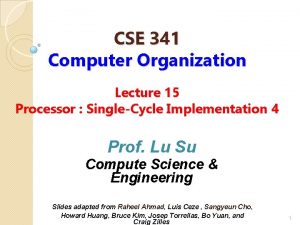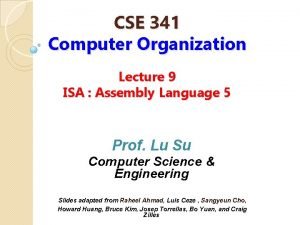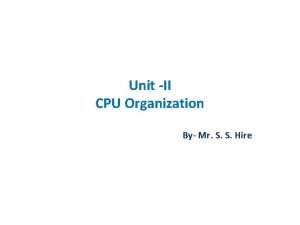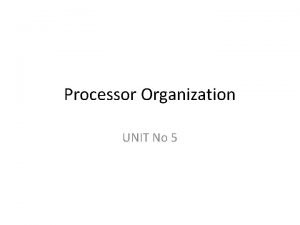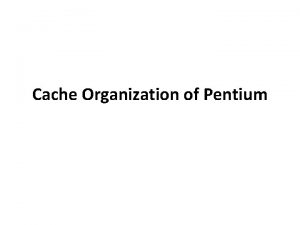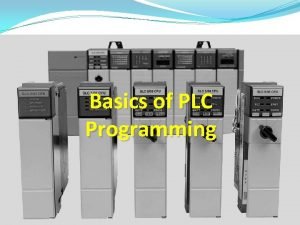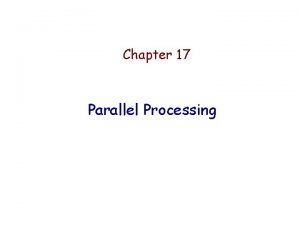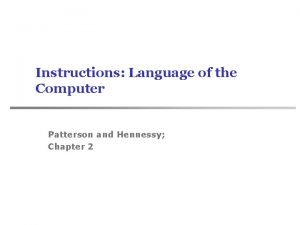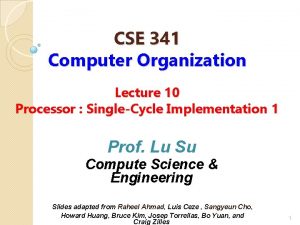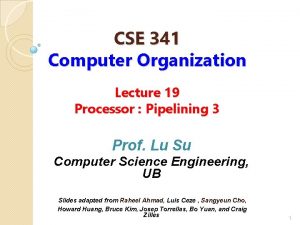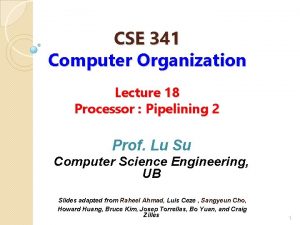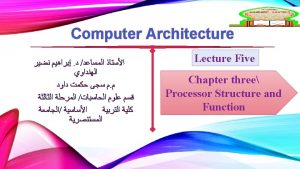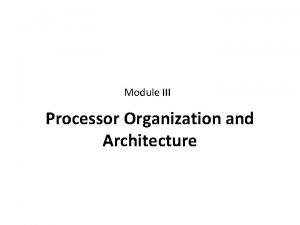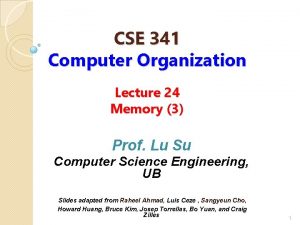CSE 341 Computer Organization Lecture 15 Processor SingleCycle













- Slides: 13

CSE 341 Computer Organization Lecture 15 Processor : Single-Cycle Implementation 4 Prof. Lu Su Compute Science & Engineering Slides adapted from Raheel Ahmad, Luis Ceze , Sangyeun Cho, Howard Huang, Bruce Kim, Josep Torrellas, Bo Yuan, and Craig Zilles 1

Control Unit Design l Right now we have not considered how to generate control signal. l A control unit is responsible for setting all the control signals -- Its input is the 32 -bit instruction word -- Its outputs are the control signals for data path l Most of the control signals can be generated from op field in the binary encoding instruction. l Next we show the generating mechanism of control signals for different types of instructions. 2

Datapath With Control

Virtual Control Unit Combine two control units into a virtual control unit. --needs 13 bits of inputs. --6 bits from op field, 6 bits from func field, 1 bit from zero output of the ALU. l Control unit has 10 bits of output (including the control signal for jump) l A little different from textbook l 4

R-type Instruction Path R-type instructions include add, sub, and, or, and slt. l ALUOp is determined by instruction’s func field. l 5

lw Instruction Path Example load instruction is lw $t 0, – 4($sp) l ALUOp is 010 (add) to compute the address 6

sw Instruction Path Example store instruction: sw $a 0, 16($sp) l ALUOp is 010 (add) to compute the address 7

beq Instruction Path Example branch instruction: beq $at, $0, offset l ALUOp is 110 (subtract), to test for equality 0 Add PC 4 Add Shift left 2 M u x 1 ALU’s Zero output indicates the equality PCSrc Reg. Write Read Instruction address [31 -0] I [25 - 21] Read register 1 I [20 - 16] Instruction memory 0 M u I [15 - 11] x 1 Read register 2 Write register Write data Read data 1 Read data 2 Registers 0 M u x 1 ALUSrc Reg. Dst I [15 - 0] ALU Zero Result ALUOp Mem. Write Mem. To. Reg Read address data 1 Write address Data Write memory data M u x 0 Mem. Read Sign extend 8

Control Signal Table �ALUOp for R-type instructions depends on the instructions’ func field. �PCSrc should be set as 1 when the instruction is beq and the zero output of ALU is 1. 9

J-type Format �J-type format: jump instruction. �Unlike branch instruction, the last field of jump instruction contains a word address instead of offset. �A 26 -bit address field allows jump to any address from 0 to 228. Word Address ! Byte Address ! 10

Implementing Jumps Jump 000010 address 31: 26 25: 0 �Jump uses word address �Update PC with concatenation of ◦ Top 4 bits of old PC ◦ 26 -bit jump address ◦ 00 �Need an extra control signal decoded from opcode

Pseudodirect Addressing � The jump address is the 26 bits of the instruction concatenated with the upper 4 bits of the PC, followed by 00. 0000 0000 11 1001 0000 0000 PC 31. . . PC 28 AD 26. . . AD 01 0 0 1001 0000 0000 1100 12

Jump 000010 address 31: 26 25: 0 Jump instructions 13
 Jump instruction
Jump instruction Isa computer organization
Isa computer organization Processor examples in computer organization
Processor examples in computer organization Process organization in computer organization
Process organization in computer organization 01:640:244 lecture notes - lecture 15: plat, idah, farad
01:640:244 lecture notes - lecture 15: plat, idah, farad Processor organization
Processor organization Processor organization
Processor organization In pentium code cache is of
In pentium code cache is of Explain plc memory organization
Explain plc memory organization Processor organization
Processor organization Tos example for elementary
Tos example for elementary Basic structure of computer in computer organization
Basic structure of computer in computer organization Architecture and organization difference
Architecture and organization difference Basic computer organization and design
Basic computer organization and design
